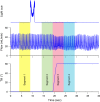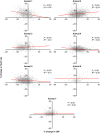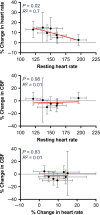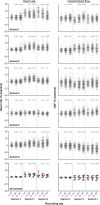Cardiovascular adjustments during anticipated postural changes
- PMID: 29333722
- PMCID: PMC5789654
- DOI: 10.14814/phy2.13554
Cardiovascular adjustments during anticipated postural changes
Abstract
It is well-documented that feedforward cardiovascular responses occur at the onset of exercise, but it is unclear if such responses are associated with other types of movements. In this study, we tested the hypothesis that feedforward cardiovascular responses occur when a passive (imposed) 60° head-up tilt is anticipated, such that changes in heart rate and carotid artery blood flow (CBF) commence prior to the onset of the rotation. A light cue preceded head-up tilts by 10 sec, and heart rate and CBF were determined for 5-sec time periods prior to and during tilts. Even after these stimuli were provided for thousands of trials spanning several months, no systematic changes in CBF and heart rate occurred prior to tilts, and variability in cardiovascular adjustments during tilt remained substantial over time. We also hypothesized that substitution of 20° for 60° tilts in a subset of trials would result in exaggerated cardiovascular responses (as animals expected 60° tilts), which were not observed. These data suggest that cardiovascular adjustments during passive changes in posture are mainly elicited by feedback mechanisms, and that anticipation of passive head-up tilts does not diminish the likelihood that a decrease in carotid blood flow will occur during the movements.
Keywords: Anticipation; cerebral blood flow; conditioned cardiovascular response; orthostatic hypotension; sympathetic nervous system.
© 2018 The Authors. Physiological Reports published by Wiley Periodicals, Inc. on behalf of The Physiological Society and the American Physiological Society.
Figures









Similar articles
-
[Arterial and venous blood flows in cats in deep respiration following orthostatic and antiorthostatic tilts].Ross Fiziol Zh Im I M Sechenova. 2001 Jan;87(1):37-42. Ross Fiziol Zh Im I M Sechenova. 2001. PMID: 11227861 Russian.
-
Role of sympathetic responses on the hemodynamic consequences of rapid changes in posture in humans.J Appl Physiol (1985). 2010 Mar;108(3):523-32. doi: 10.1152/japplphysiol.01185.2009. Epub 2010 Jan 7. J Appl Physiol (1985). 2010. PMID: 20056846
-
Effects of postural changes and removal of vestibular inputs on blood flow to the head of conscious felines.J Appl Physiol (1985). 2006 May;100(5):1475-82. doi: 10.1152/japplphysiol.01585.2005. Epub 2006 Jan 26. J Appl Physiol (1985). 2006. PMID: 16439511
-
Age-related changes in the sympathetic innervation of cerebral vessels and in carotid vascular responses to norepinephrine in the rat: in vitro and in vivo studies.J Appl Physiol (1985). 2010 Aug;109(2):314-22. doi: 10.1152/japplphysiol.01251.2009. Epub 2010 May 13. J Appl Physiol (1985). 2010. PMID: 20466800
-
Changes in regional blood flow and cardiodynamics evoked by electrical stimulation of the fastigial nucleus in the cat and their similarity to orthostatic reflexes.J Physiol. 1972 Dec;227(3):729-47. doi: 10.1113/jphysiol.1972.sp010056. J Physiol. 1972. PMID: 4650936 Free PMC article.
Cited by
-
Responses of neurons in the rostral ventrolateral medulla of conscious cats to anticipated and passive movements.Am J Physiol Regul Integr Comp Physiol. 2020 Mar 1;318(3):R481-R492. doi: 10.1152/ajpregu.00205.2019. Epub 2020 Jan 15. Am J Physiol Regul Integr Comp Physiol. 2020. PMID: 31940234 Free PMC article.
-
Physiological changes associated with copper sulfate-induced nausea and retching in felines.Front Physiol. 2023 Jan 19;14:1077207. doi: 10.3389/fphys.2023.1077207. eCollection 2023. Front Physiol. 2023. PMID: 36744037 Free PMC article.
-
Responses of Neurons in the Medullary Lateral Tegmental Field and Nucleus Tractus Solitarius to Vestibular Stimuli in Conscious Felines.Front Neurol. 2020 Dec 18;11:620817. doi: 10.3389/fneur.2020.620817. eCollection 2020. Front Neurol. 2020. PMID: 33391176 Free PMC article.
-
Cardiovascular response to anticipatory and reactionary postural perturbations in young adults.Exp Physiol. 2023 Sep;108(9):1144-1153. doi: 10.1113/EP091173. Epub 2023 Jul 17. Exp Physiol. 2023. PMID: 37458232 Free PMC article.
References
-
- Armstrong, R. B. , Hayes D. A., and Delp M. D.. 1989. Blood flow distribution in rat muscles during preexercise anticipatory response. J. Appl. Physiol. 67:1855–1861. - PubMed
-
- Arshian, M. , Holtje R. J., Cotter L. A., Rice C. D., Cass S. P., and Yates B. J.. 2017. Consequences of postural changes and removal of vestibular inputs on the movement of air in and out of the lungs of conscious felines. J. Appl. Physiol. 103:347–352. - PubMed
-
- Blomqvist, C. , and Stone H.. 1983. Cardiovascular adjustments to gravitational stress Pp. 1025–1063 in Shepherd J. T. and Abboud F. M., eds. Handbook of Physiology, The Cardiovascular System, Sect 2 Vol. III American Physiological Society, Bethesda.
-
- Cohen, D. H. , and Randall D. C.. 1984. Classical conditioning of cardiovascular responses. Annu. Rev. Physiol. 46:187–197. - PubMed
Publication types
MeSH terms
Grants and funding
LinkOut - more resources
Full Text Sources
Other Literature Sources
Medical

